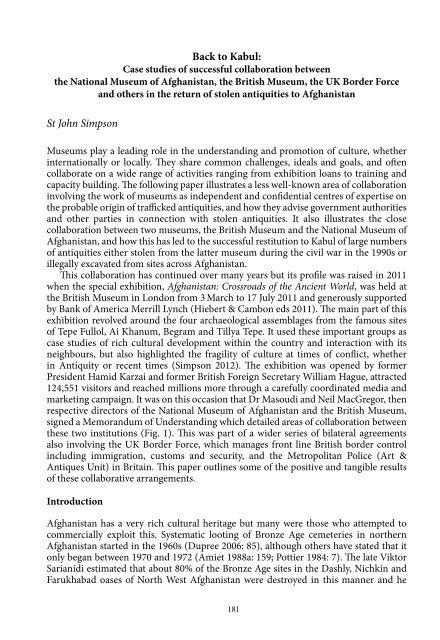Countering
Book_observatory_illicit_traffic_version%20issuu
Book_observatory_illicit_traffic_version%20issuu
Create successful ePaper yourself
Turn your PDF publications into a flip-book with our unique Google optimized e-Paper software.
St John Simpson<br />
witnessed large-scale daylight looting in progress during the 1970s (Fig. 2). Moreover, on<br />
the basis of personal observations, he surmised that these looted burials belonged to the<br />
same types as he had excavated shortly before at Dashly and Farukhabad. Unfortunately,<br />
the fact they were in brick-lined pits facilitated their discovery as he reported that ‘such<br />
graves are easily discovered by looters who scrape and bang their shovels to detect the<br />
hollow pits’ (cf. Kohl 1984: 160-169). Large quantities of objects from these cemeteries<br />
soon began to appear in the shops and pavement stalls of petty dealers in the bazaars of<br />
Balkh, Mazar-i Sharif and Kabul, along with medieval pottery, ethnographic items and<br />
beads (Fig. 3). As many as 332 items spanning most of the typical classes of metalwork<br />
and stone objects circulating through the Kabul bazaar during the winter of 1978-1979<br />
were recorded by Marie-Hélène Pottier (1984), and a selection of these was later acquired<br />
by the Musée du Louvre (Amiet 1988a: p. 159). Other types, including decorated silver<br />
and gold vessels, appeared on the Kabul art market in 1975 (Deshayes 1977, Figs. 7-8).<br />
When I arrived in Afghanistan in summer 1975 and expressed an interest in its Bronze Age, I was<br />
told to visit the Kabul bazaar to learn what was known. It made sense to inspect and familiarize<br />
myself with the clandestinely excavated vessels, seals, metal and stone tools and weapons, and<br />
precious jewelry before they were shipped to the West (Kohl 2005: 65).<br />
As this archaeologist implies, these classes of object soon began to pass onto the<br />
international market via neighbouring countries, and this pattern of circulation has<br />
continued up until the present day. As the first discoveries coincided with similar finds<br />
being reported from commercial and archaeological investigations at Shahdad in the<br />
Kerman region of South East Iran, the objects also began to be bought up by Tehran<br />
dealers and entered the Iranian, as well as international, art market where they were<br />
consequently catalogued as ‘Elamite’ and commanded higher prices.<br />
Amiet (1988b: 135) has explicitly stated that Iranian dealers were buying up material<br />
on the Afghan market and ‘it would thus appear that most of the items which the dealers<br />
attributed to the province of Kerman actually came from Bactria’. The mixed date-range<br />
of pieces offered in Kabul doubtless meant that later (including Islamic) objects entered<br />
these interwoven markets at the same time, and Dupree (2002: 8) has remarked on how<br />
‘even Islamic gravestones were not spared, as they find a ready market in Iran’. Moreover,<br />
given the large-scale flow of opium and heroin from Afghanistan into Russia via the<br />
intervening countries, it is likely that other antiquities passed north, particularly through<br />
the railway system. Lee (2000) has commented on how items from Bactria have been<br />
sent in recent years via Uzbekistan into Russia, and others were driven over the border<br />
into Iran. Moreover, during the mid-1990s, the author saw medieval metalwork on open<br />
sale in the Sunday bazaar in Ashgabat: the objects were said to come from Merv but were<br />
certainly not from that site as there were no traces of illegal digging there or indeed other<br />
sites visited in the area, and it is more likely that they derived from Afghanistan.<br />
This period of the 1990s coincides with the civil war in Afghanistan, when looting<br />
reached its highest levels and museums as well as sites were targeted. Large sites were<br />
a particular focus of attention, and the scale of destruction well documented at Ai<br />
Khanum (Bernard 2001, Figs. 7, 9, 18, 22) and Tepe Zargaran, where looters’ pits and<br />
tunnels penetrated up to five metres below the surface and the fine stonework which<br />
characterised the earliest levels had been especially sought after (Bernard, Besenval &<br />
Marquis 2006: 1178 and 1188, Figs. 2-3; Bernard, Jarrige & Besenval 2002: 1403-408;<br />
Tarzi & Feroozi 2004: 4-5, Figs. 8-10).<br />
The causes of looting of museums and stores are multiple and include opportunism,<br />
182


